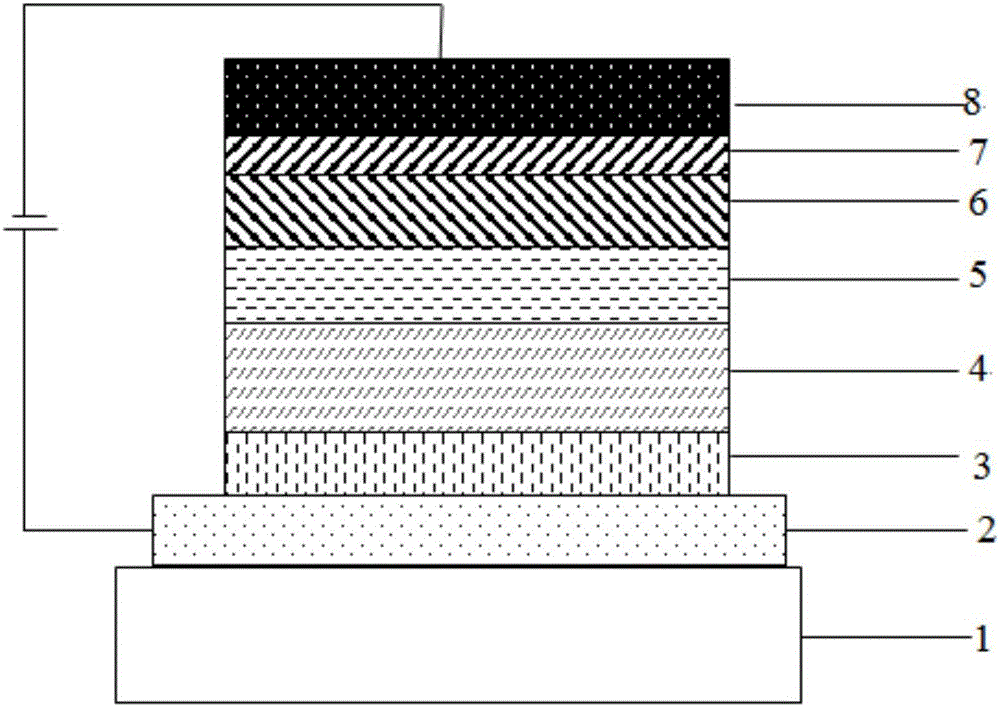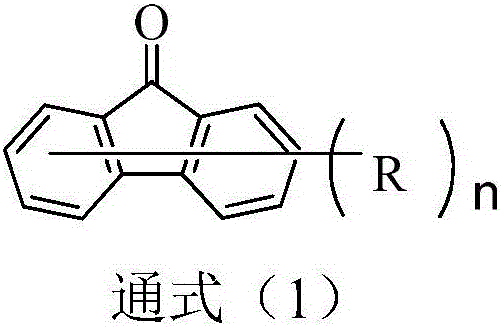Organic electroluminescent material with 9-fluorenone as core and application thereof
A luminescent and electromechanical technology, applied in luminescent materials, organic chemistry, circuits, etc., can solve problems such as efficiency roll-off, low S1 state radiation transition rate, difficult exciton utilization rate and high fluorescence radiation efficiency
- Summary
- Abstract
- Description
- Claims
- Application Information
AI Technical Summary
Problems solved by technology
Method used
Image
Examples
Embodiment 1
[0076] Embodiment 1: the synthesis of compound 11:
[0077] synthetic route:
[0078]
[0079] In a 250mL three-neck flask, under a nitrogen atmosphere, add 0.01mol 2-bromo-9-fluorenone, 0.015mol intermediate A1, 0.03mol sodium tert-butoxide, 1×10 -4 molPd(dppf)Cl 2 , 180mL toluene, heated to reflux for 10 hours, sampled and spotted, the raw materials were completely reacted; naturally cooled to room temperature (20-25°C), filtered, and the filtrate was collected for vacuum rotary evaporation (-0.09MPa, 85°C), and column chromatography , to obtain the target product with a HPLC purity of 99.1% and a yield of 73.2%.
[0080] Elemental analysis structure (molecular formula C 46 h 30 N 2 o 2 ): theoretical value C, 85.96; H, 4.70; N, 4.36; 0, 4.98; test value: C, 85.95;
[0081] HPLC-MS: The theoretical molecular weight of the material is 642.74, and the measured molecular weight is 642.97.
Embodiment 2
[0082] Embodiment 2: the synthesis of compound 17:
[0083] synthetic route:
[0084]
[0085] In a 250mL three-neck flask, under a nitrogen atmosphere, add 0.01mol 2-bromo-9-fluorenone, 0.015mol intermediate B1, 0.03mol sodium tert-butoxide, 1×10 -4 molPd(dppf)Cl 2 , 180mL toluene, heated to reflux for 10 hours, sampled and spotted, the raw materials were completely reacted; naturally cooled to room temperature (20-25°C), filtered, and the filtrate was collected for vacuum rotary evaporation (-0.09MPa, 85°C), and column chromatography , the target product was obtained, the HPLC purity was 99.3%, and the yield was 74.8%.
[0086] Elemental analysis structure (molecular formula C 46 h 30 N 2 o 2 ): theoretical value C, 85.96; H, 4.70; N, 4.36; O, 4.98; test value: C, 85.94; H, 4.72; N, 4.37;
[0087] HPLC-MS: The theoretical molecular weight of the material is 642.74, and the measured molecular weight is 642.95.
Embodiment 3
[0088] Embodiment 3: the synthesis of compound 38:
[0089] synthetic route:
[0090]
[0091] In a 250mL three-neck flask, under a nitrogen atmosphere, add 0.01mol 2-bromo-9-fluorenone, 0.015mol intermediate C1, 0.03mol sodium tert-butoxide, 1×10 -4 molPd(dppf)Cl 2 , 180mL toluene, heated to reflux for 10 hours, sampled and spotted, the raw materials were completely reacted; naturally cooled to room temperature (20-25°C), filtered, and the filtrate was collected for vacuum rotary evaporation (-0.09MPa, 85°C), and column chromatography , to obtain the target product with a HPLC purity of 99.5% and a yield of 74.2%.
[0092] Elemental analysis structure (molecular formula C 49 h 36 N 2 o 2 ): theoretical value C, 85.94; H, 5.30; N, 4.09; 0, 4.67; test value: C, 85.95;
[0093] HPLC-MS: The theoretical molecular weight of the material is 684.82, and the measured molecular weight is 685.04.
PUM
| Property | Measurement | Unit |
|---|---|---|
| Thickness | aaaaa | aaaaa |
Abstract
Description
Claims
Application Information
 Login to View More
Login to View More - R&D
- Intellectual Property
- Life Sciences
- Materials
- Tech Scout
- Unparalleled Data Quality
- Higher Quality Content
- 60% Fewer Hallucinations
Browse by: Latest US Patents, China's latest patents, Technical Efficacy Thesaurus, Application Domain, Technology Topic, Popular Technical Reports.
© 2025 PatSnap. All rights reserved.Legal|Privacy policy|Modern Slavery Act Transparency Statement|Sitemap|About US| Contact US: help@patsnap.com



